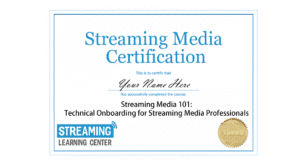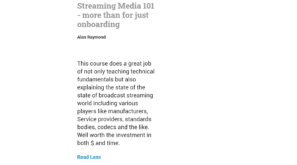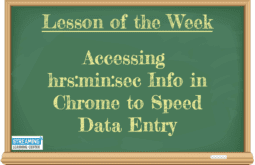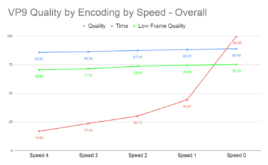If you’re onboarding new hires in streaming media-related positions, you now have an affordable option for providing and monitoring that streaming-specific training. If you’re a professional seeking to upgrade your skills and gain accreditation, you have that option as well. Over the last few years, streaming media has become critical for entertainment and communications, with the quarantines necessitated by Covid-19 …
Read More »MediaMelon’s SmartPlay Cuts Bandwidth Requirements Without Re-encoding
We’re all aware of the sudden need to reduce streaming bandwidth to alleviate congestion. MediaMelon’s SmartPlay/QBR is a very viable option for this that was recently adopted by Brazilian OTT producer Telecine. I reviewed MediaMelon’s QBR technology for Streaming Media Magazine back in 2017. I called it a “server-side, per-title delivery mechanism.” Unlike traditional per-title technologies that re-encode your files …
Read More »Tuning for Metrics: What About VMAF and VP9?
If you’re comparing codecs with video quality metrics, you should consider tuning for that metric. However, x264 and x265 don’t have a VMAF tuning option. According to my analysis, it appears that tuning for PSNR is the best option and one you should strongly consider. When working with VP9, there’s an additional complication; tuning for PSNR doesn’t appear to work. …
Read More »Five Star Review of Streaming Media 101-Technical Onboarding for Streaming Media Professionals
The first review is up for my new course, Streaming Media 101 – Technical Onboarding for Streaming Media Professionals, and it’s a five-star review. I designed the course to provide technical fundamentals and an overview of key industry products and services and the companies that create and support them. The goal was to teach students skills like live and VOD …
Read More »Lesson of the Week: Accessing hr:min:sec Info in Chrome to Speed Data Entry
Producing the chart above involved encoding 35 files using 5 different presets and then recording start and stop times. Since the files were about 20-seconds long, seconds were important. I’m sure a smarter compressionist than I could write a Python script to harvest the start and stop times but I do it by hand, which is complicated because Windows Explorer …
Read More »Encoding VP9 in FFmpeg: An Update
This is a long post only of interest to those attempting to optimize their VP9 encodes. The three key takeaways are 1) use the command script shown on the bottom of the page, 2) a speed setting of 2 offers the optimal quality/performance tradeoff, and 3) the row-mt setting improves performance significantly with zero quality loss when multiple unused cores …
Read More »VMAF is Hackable: What Now?
Just a quick note to let you know about some recent findings relating to the Netflix VMAF metric. By way of background, VMAF launched in June 2016 as the metric that powered Netflix’s per-title encoding engine, replacing PSNR. The fact that Netflix created and used VMAF gave the metric tremendous credibility and because Netflix open-sourced VMAF it was quickly added …
Read More »Lesson of the Week: Sounding Good Online – Exploring Your Mic Options
In a previous lesson, I explored how to optimize quality on a webcam; this lesson tackles the audio side. Rather than simply discuss the various options I recorded multiple segments using the mics shown below so you can hear the difference. I shot all segments under the same conditions, in my office with fluorescent lights running, which caused the faint hum …
Read More »Interview with Streaming Media About New Course: Streaming Media 101
I spoke with Streaming Media Magazine’s Eric Schumacher-Rasmussen about the new course, Streaming Media 101: Technical Onboarding for Streaming Media Professionals. The video is available on YouTube so I embedded it below. If you’d rather read the transcript, click here to see the article on the Streaming Media website. Eric’s second question was “what’s the elevator pitch?” Here’s the …
Read More »New Course – Streaming Media 101: Technical Onboarding for Streaming Media Professionals
I’m launching a new video course called Streaming Media 101: Technical Onboarding for Streaming Media Professionals. As the name suggests, the course teaches the technical background and skills necessary to successfully perform in a streaming-media related job, whether it’s producing and distributing video, or in a company creating the tools or services necessary to produce and distribute streaming media. Streaming …
Read More » Streaming Learning Center Where Streaming Professionals Learn to Excel
Streaming Learning Center Where Streaming Professionals Learn to Excel












